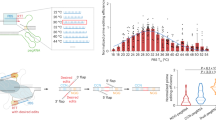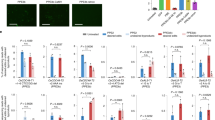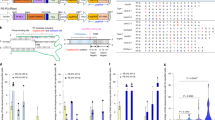Abstract
Prime editing (PE) applications are limited by low editing efficiency. Here we show that designing prime binding sites with a melting temperature of 30 °C leads to optimal performance in rice and that using two prime editing guide (peg) RNAs in trans encoding the same edits substantially enhances PE efficiency. Together, these approaches boost PE efficiency from 2.9-fold to 17.4-fold. Optimal pegRNAs or pegRNA pairs can be designed with our web application, PlantPegDesigner.
This is a preview of subscription content, access via your institution
Access options
Access Nature and 54 other Nature Portfolio journals
Get Nature+, our best-value online-access subscription
$29.99 / 30 days
cancel any time
Subscribe to this journal
Receive 12 print issues and online access
$209.00 per year
only $17.42 per issue
Buy this article
- Purchase on Springer Link
- Instant access to full article PDF
Prices may be subject to local taxes which are calculated during checkout


Similar content being viewed by others
Data availability
All data supporting the findings of this study are available in the article and its supplementary figures and tables or can be obtained from the corresponding authors upon reasonable request. For sequence data, rice locus identifiers (http://rice.plantbiology.msu.edu/) are as follows:
LOC_Os01g55540 (OsAAT), LOC_Os05g22940 (OsACC), LOC_Os03g54790 (OsALS), LOC_Os03g05730 (OsCDC48), LOC_Os09g26999 (OsDEP1), LOC_Os06g04280 (OsEPSPS), LOC_Os08g39890 (OsIPA1); LOC_Os10g40600 (OsNRT1.1B), LOC_Os08g03290 (OsGAPDH), LOC_Os03g08570 (OsPDS) and LOC_Os06g35970 (OsROC5). The deep sequencing data have been deposited in a National Center for Biotechnology Information BioProject database (accession code PRJNA702010). Plasmids pSpG-PPE, pOsU3, pTaU3 and pH-nCas9-PPE-V2 will be available through Addgene.
Code availability
The PlantPegDesigner web application code is available at GitHub (https://github.com/JinShuai001/PlantPegDesigner). The web portal server is accessible at http://www.plantgenomeediting.net for non-profit use.
References
Chen, K., Wang, Y., Zhang, R., Zhang, H. & Gao, C. CRISPR/Cas genome editing and precision plant breeding in agriculture. Annu. Rev. Plant Biol. 70, 667–697 (2019).
Jiao, R. & Gao, C. Anything impossible with CRISPR/Cas9? Sci. China Life Sci. 60, 445–446 (2017).
Anzalone, A. V. et al. Search-and-replace genome editing without double-strand breaks or donor DNA. Nature 576, 149–157 (2019).
Lin, Q. et al. Prime genome editing in rice and wheat. Nat. Biotechnol. 38, 582–585 (2020).
Tang, X. et al. Plant prime editors enable precise gene editing in rice cells. Mol. Plant 13, 667–670 (2020).
Li, H., Li, J., Chen, J., Yan, L. & Xia, L. Precise modifications of both exogenous and endogenous genes in rice by prime editing. Mol. Plant 13, 671–674 (2020).
Xu, W. et al. Versatile nucleotides substitution in plant using an improved prime editing system. Mol. Plant 13, 675–678 (2020).
Xu, R. et al. Development of plant prime-editing systems for precise genome editing. Plant Commun. 1, 100043 (2020).
Hua, K., Jiang, Y., Tao, X. & Zhu, J. K. Precision genome engineering in rice using prime editing system. Plant Biotechnol. J. 18, 2167–2169 (2020).
Butt, H. et al. Engineering herbicide resistance via prime editing in rice. Plant Biotechnol. J. 18, 2370–2372 (2020).
Jiang, Y. et al. Prime editing efficiently generates W542L and S621I double mutations in two ALS genes of maize. Genome Biol. 21, 257 (2020).
Liu, Y. et al. Efficient generation of mouse models with the prime editing system. Cell Discov. 6, 27 (2020).
Surun, D. et al. Efficient generation and correction of mutations in human iPS cells utilizing mRNAs of CRISPR base editors and prime editors. Genes 11, 511 (2020).
Kaback, D. B., Angerer, L. M. & Davidson, N. Improved methods for the formation and stabilization of R-loops. Nucleic Acids Res. 6, 2499–2517 (1979).
Walton, R. T. et al. Unconstrained genome targeting with near-PAMless engineered CRISPR–Cas9 variants. Science 368, 290–296 (2020).
Bhagwat, A. M. et al. multicrispr: gRNA design for prime editing and parallel targeting of thousands of targets. Life Sci. Alliance 3, e202000757 (2020).
Chow, R. D., Chen, J. S., Shen, J. & Chen, S. A web tool for the design of prime-editing guide RNAs. Nat. Biomed. Eng. 5, 190–194 (2020).
Hsu, J. Y. et al. PrimeDesign software for rapid and simplified design of prime editing guide RNAs. Nat. Commun. 12, 1034 (2021).
Morris, J. A., Rahman, J. A., Guo, X. & Sanjana, N. E. Automated design of CRISPR prime editors for thousands of human pathogenic variants. Preprint at https://www.biorxiv.org/content/10.1101/2020.05.07.083444v1 (2020)
Kim, H. K. et al. Predicting the efficiency of prime editing guide RNAs in human cells. Nat. Biotechnol. 39, 198–206 (2020).
Shan, Q. et al. Targeted genome modification of crop plants using a CRISPR–Cas system. Nat. Biotechnol. 31, 686–688 (2013).
Zong, Y. et al. Efficient C-to-T base editing in plants using a fusion of nCas9 and human APOBEC3A. Nat. Biotechnol. 36, 950–953 (2018).
Acknowledgements
This work was supported by grants from the National Transgenic Science and Technology Program of China (2019ZX08010-001 and 2019ZX08010-003), the Strategic Priority Research Program of the Chinese Academy of Sciences (Precision Seed Design and Breeding, XDA24020310 and XDA24030504) and the National Natural Science Foundation of China (31788103 and 32001060).
Author information
Authors and Affiliations
Contributions
Q.L., S.J., Y.Z., J.Q., J.L. and C.G. designed the project. Q.L., Y.Z., S.J., Z.Z., G.L. and Y.W. performed the experiments. H.Y., S.J. and L.K. developed the web application. Q.L., S.J., Y.Z., J.Q., J.L. and C.G. wrote the manuscript. J.L. and C.G. supervised the project.
Corresponding authors
Ethics declarations
Competing interests
The authors have submitted a patent application based on the results reported in this paper.
Additional information
Peer review information Nature Biotechnology thanks the anonymous reviewers for their contribution to the peer review of this work.
Publisher’s note Springer Nature remains neutral with regard to jurisdictional claims in published maps and institutional affiliations.
Supplementary information
Supplementary Information
Supplementary Figs. 1–7, Tables 1–7 and Notes 1–4
Rights and permissions
Springer Nature or its licensor (e.g. a society or other partner) holds exclusive rights to this article under a publishing agreement with the author(s) or other rightsholder(s); author self-archiving of the accepted manuscript version of this article is solely governed by the terms of such publishing agreement and applicable law.
About this article
Cite this article
Lin, Q., Jin, S., Zong, Y. et al. High-efficiency prime editing with optimized, paired pegRNAs in plants. Nat Biotechnol 39, 923–927 (2021). https://doi.org/10.1038/s41587-021-00868-w
Received:
Accepted:
Published:
Issue Date:
DOI: https://doi.org/10.1038/s41587-021-00868-w



